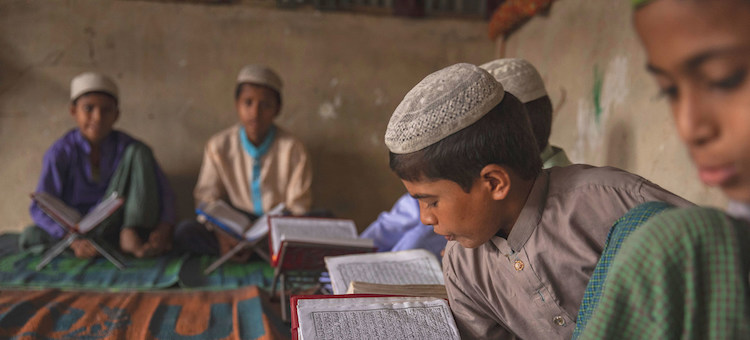By Sean Buchanan
NEW YORK (IDN) – The daily struggle to survive for Myanmar’s Rohingya people in some of the world’s largest refugee settlements has caused overwhelming despair and jeopardised the hopes of an entire generation, according to the head of the UN Children’s Fund (UNICEF), Henrietta Fore.
In a report marking two years since the arrival of around 745,000 Rohingya civilians in Bangladesh – after fleeing State-led persecution and violence in Myanmar – UNICEF Executive Director Fore appealed for urgent investment in education and skills training.
“For the Rohingya children and youth now in Bangladesh, mere survival is not enough,” she said. “It is absolutely critical that they are provided with the quality learning and skills development that they need to guarantee their long-term future.”
Without adequate learning opportunities, youngsters can fall prey to drug dealers and traffickers who offer to smuggle “desperate” ethnic Rohingya out of Bangladesh, the UN report entitled ‘Beyond Survival: Rohingya Refugee Children Want to Learn’ warned.
For the last two years, more than 900,000 stateless Rohingya refugees living in the camps of southeast Bangladesh have focused on staying alive.
New infrastructure and efforts aimed at providing the basics of health care, nutrition, and water, sanitation and hygiene, have improved conditions for the children and families who fled persecution and violence in Myanmar.
The Rohingya found refuge among an already vulnerable population in the Cox’s Bazar district. As of August 2019, a total of 1.2 million people – including 683,000 children – were in need of humanitarian assistance.
The vast majority of the recent arrivals live in flimsy bamboo and tarpaulin shelters. They are places where – despite a sense of stability – the dangers of everyday life remain all too real.
Women and girls face harassment and abuse especially at night, UNICEF noted, while adding that one of the agency’s objectives through education is to give teenagers the skills they need to deal avoid “many risks”, including early marriage for girls.
Living conditions are often described as perilous by UN humanitarians, including UNICEF, which have issued frequent alerts about the devastating effects of monsoon rains on flimsy bamboo and tarpaulin shelters.
Between April 21 and July 18 this year, refugee camp authorities recorded 42 injuries and 10 fatalities, including six children, because of monsoon weather, according to UNICEF.
Amid huge needs – and with conditions still unsuitable for the return of ethnic Rohingya to Myanmar, according to the UN Refugee Agency (UNHCR) – basic public services have been provided in Cox’s Bazar, including health care, nutrition, water, sanitation and hygiene, under the leadership of Bangladesh.
But as the refugee crisis drags on, children and young people are clamouring for more than survival; they want quality education that can provide a path to a more hopeful future.
“I studied six subjects back in Myanmar,” said Abdullah, 18, who lives in the Kutupalong refugee camp, the largest in the world. “But when I arrived here, there was no way I could continue.” “If we do not get education in the camps, I think our situation is going to be dire,” he added.
For children and young people, the protracted state of limbo has awoken an intense desire for learning opportunities that prepare them for the future.
When the huge influx of refugees began in 2017, UNICEF and partners responded by setting up large numbers of learning centres in the camps. For children unable to find space in these centres, other options have emerged: religious schools (madrasas) provide free lessons in Koranic studies, Arabic and other subjects; and private and group tutors offer classes for those who can afford them.
By June 2019, the overall education sector had provided non-formal education to 280,000 children aged 4 to 14. UNICEF and its partners have ensured access to learning for 192,000 of those children, enrolled in 2,167 learning centres.
At the same time, this leaves a gap of over 25,000 children not attending any learning programmes, while an additional 640 learning centres are needed. Furthermore, an estimated 97 percent of adolescents and youth aged 15 to 18 years are not enrolled in any type of learning facility.
Parents are concerned that the longer their children are deprived of education, the greater the risk that they will be exposed to exploitation and abuse. “Educated people have a value wherever they are,” said Mohamed Hussein, who sends two of his children to a learning centre in Camp 18. “Whether my son goes back to Myanmar or to Malaysia or anywhere else, the same is true.”
In an appeal to the Governments of Bangladesh and Myanmar, UNICEF and other agencies are calling for the use of national educational resources – curricula, training manuals and assessment methods – to help provide more structured learning for Rohingya children.
“Providing learning and training materials is a huge task and can only be realised with the full backing of a range of partners,” UNICEF’s Fore said. “But the hopes of a generation of children and adolescents are at stake. We cannot afford to fail them.” [IDN-InDepthNews – 18 August 2019]
Photo: A boy reads from his textbook in a camp in Cox’s Bazar, Bangladesh. Credit: UNICEF Patrick Brown


